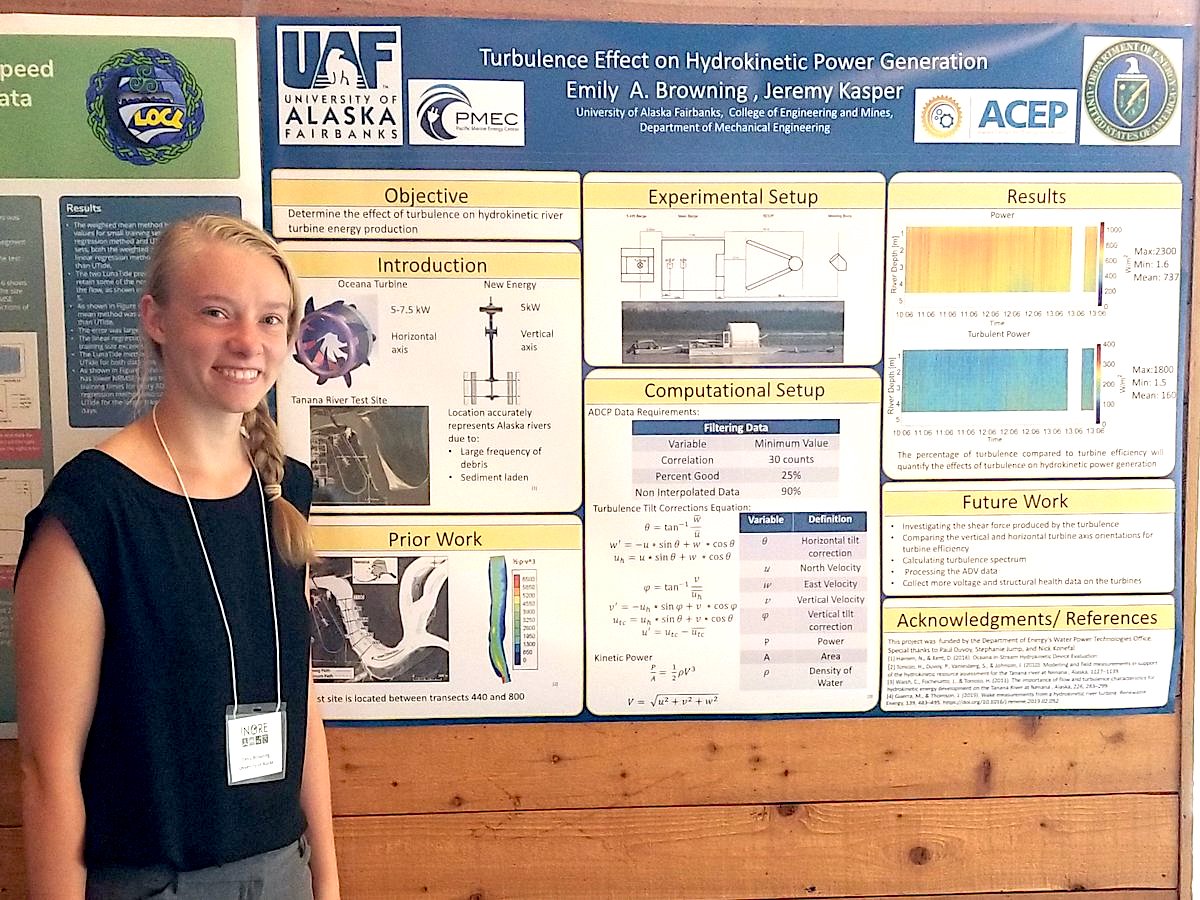By Ali Trueworthy 22 July 2019
Computer rendering of hydrokinetic turbine
At the University of Alaska at Fairbanks, hydrokinetic energy is more than just a research topic, it is a possible solution to some pressing local challenges. There are more than two hundred remote villages in Alaska that currently depend on high-polluting diesel generators for power production. These communities rely on a constant supply of diesel fuel that must be brought in by truck, ship or airplane. Developing energy generation in these communities with the renewable resources available on site could significantly mitigate the environmental impacts of shipping and burning diesel and create a more reliable electricity system. Hydrokinetic energy collected from river currents by underwater turbines may be able to provide an alternative.
The V-shaped structure is the debris diversion device necessary for preventing things floating in the river from damaging the turbine
Emily Browning, a first-year grad student with Professor Jeremy Kasper, is passionate about the local impacts of her research in the effects of turbulence on hydrokinetic turbine performance. She hopes that as she continues research, she will get the opportunity to visit and work with some of these communities. When I asked her why turbulence was such an important aspect to consider, her answer was likewise locally-minded.
She explained, beginning with the fundamentals- the moving water in a river contains kinetic energy, the energy of motion. There is energy in both steady, or laminar, flow as well as turbulent flow in the river. As you might imagine, hydrokinetic turbines are designed to harvest the laminar flow. But a significant amount of energy is contained in turbulent flow.
Along with huge quantities of icy water, Alaska’s rivers carry logs, plants and other organic debris, which means that the hydrokinetic turbines must have debris diversion devices. The debris diversion devices increase the turbulence in the water near the turbines, making understanding its impacts even more important in Alaskan rivers.
Over two summers before Emily arrived at UAF, researchers and colleagues collected river flow data on the Tanana river in Nenana, Alaska. They measured the flow of the river using a device called an Acoustic Doppler Current Profiler, or ADCP. An ADCP uses sounds waves to determine how fast water is flowing, transmitting and receiving sound signals from four beams. They also deployed two hydrokinetic turbines and collected data on how much power the turbines collected. The current profilers were placed in front of the turbines where the flow was undisturbed by their presence.
Photo from a previous turbine deployment when a tree got caught in the turbine
Now Emily has heaps of data to work with- river current and turbine power output for two turbine designs over two summers. To convert to ADCP data into a usable measurement of the amount of turbulence in the water, Emily must first validate the data. Each beam of the ADCP gives a measurement of the current, and data is only considered valid when, within a ten-minute interval, at least 90% of the data match between the four beams. When a chunk of data is determined to be valid, any missing points can be interpolated, and the amount of turbulence can be determined. Emily compares the amount of turbulence in the water to the power output of the turbine.
So far, most of Emily’s work has been on writing code that can properly deal with the enormous amount of data. When we met at the International Network on Offshore Renewable Energy (INORE) symposium in Victoria, British Columbia, Emily was wrapping up her data validation and analysis code, about to start running it for the 2 seasons of data, each for 2 different turbines. She had the bright eyes of a researcher about to get some long-sought results. Luckily for me and the many other graduate students at INORE, she took a break from seeking results to come share her work, experiences living in Fairbanks, and serious basketball-in-sandals skills!
Emily Browning presenting her poster on hydrokinetic river turbines in Alaska at the 2019 International Network on Offshore Renewable Energy Symposium in Victoria, Canada.





